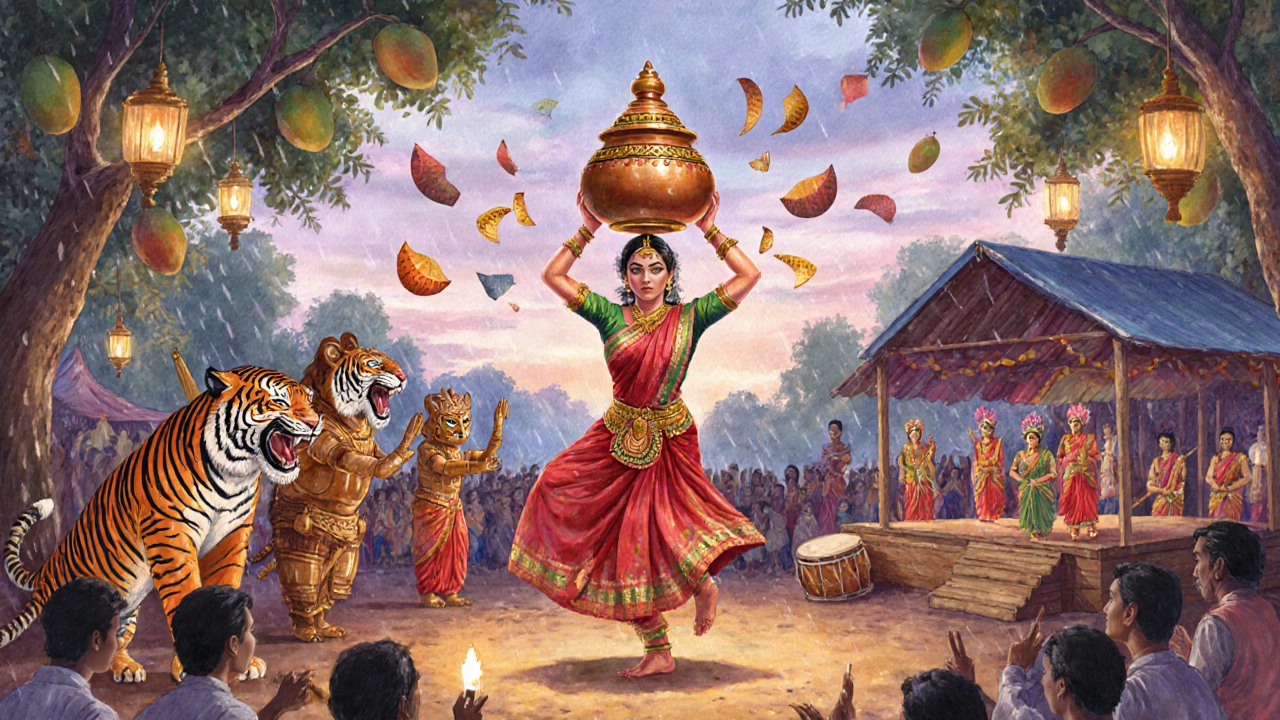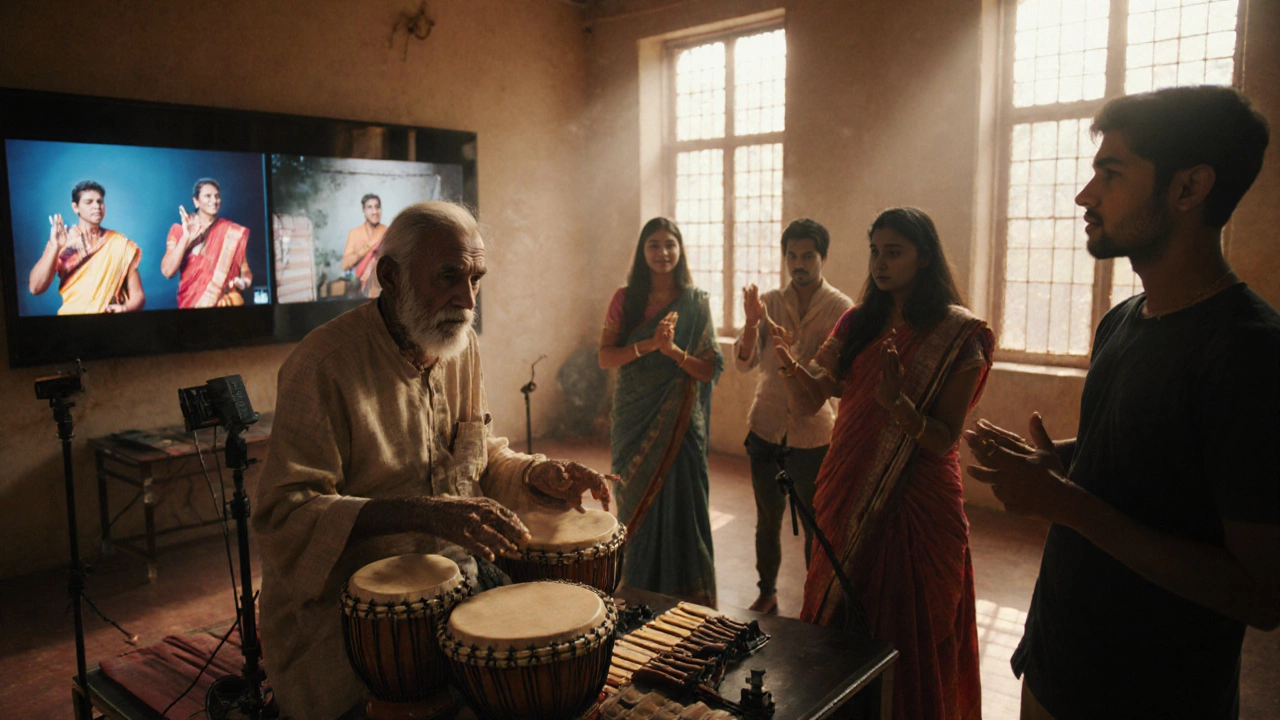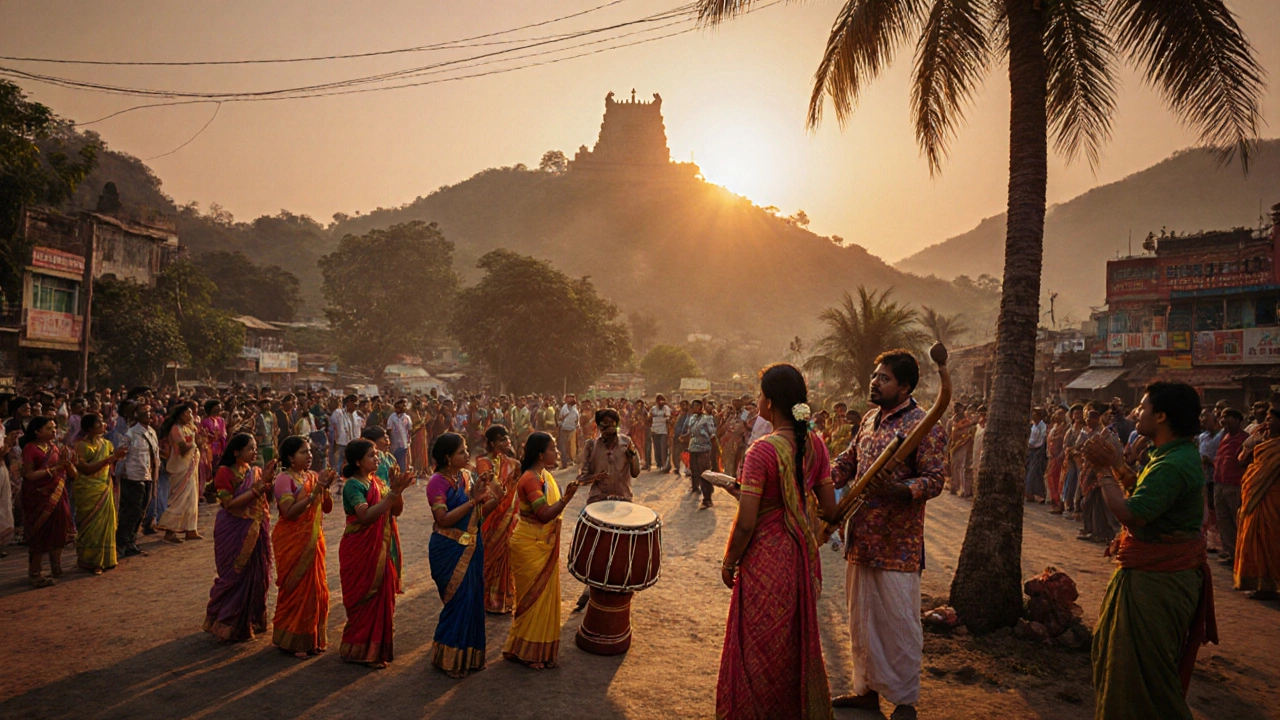Tamil Folk Art Explorer
Filter by Theme
When people talk about Tamil folklore is a rich tapestry of myths, folk songs, dances, and rituals that have been passed down in Tamil Nadu for centuries, they are really describing a living archive of community memory. From the bustling streets of Chennai to the quiet villages of the Western Ghats, folk traditions shape how people celebrate, mourn, work and tell stories. This guide walks you through the main strands of Tamil Nadu’s folklore, shows why each piece matters, and offers practical pointers if you want to experience them first‑hand.
Roots of Tamil Folklore
Folklore in Tamil Nadu grew out of three overlapping foundations: the ancient Tamil language, the agrarian calendar, and a pantheon of local deities. The earliest Sangam poems already hint at oral narratives that later became full‑blown legends. As rice cycles dictated festivals, villagers crafted songs and dances to thank the earth gods, ensuring the next harvest. Over time these practices blended with Dravidian mythic motifs, giving rise to a distinctive cultural flavor that differs from the classical Sanskrit‑influenced stories of North India.
Mythic Themes and Legends
Many folk tales revolve around heroic locals, clever tricksters, and moral lessons. The story of Vallalar a saint‑poet who walked on water after attaining divine compassion is retold in village squares during temple festivals. Another popular saga tells of the clever rabbit that outwits a boastful crocodile, teaching children humility. These narratives travel orally, often accompanied by a Villu Paatu storytelling art that uses a bow-shaped instrument to punctuate dialogue - a portable, rhythmic device that keeps the audience hooked.
Folk Music and Oral Traditions
Music is the heartbeat of Tamil folklore. The Parai a frame drum traditionally played by the Dalit community during processions sets a thunderous rhythm for marching songs that announce weddings or announce a war hero’s return. In contrast, Kummi a hand‑clapping folk song performed by women during harvest festivals uses simple melodic patterns that anyone can join. Both styles emphasize call‑and‑response, letting the crowd become an instrument itself.

Dance Forms and Performances
From the swaying palms of coastal villages comes Karakattam a dance where performers balance a decorated pot on their heads while moving to folk tunes. The pot, called a "karakam," symbolizes the rain‑god Indra; dancers invoke plentiful monsoons through graceful, kinetic balance. In the southern districts, you’ll see Puliyattam a lion‑dance where participants wear elaborate tiger masks and wooden body armor. The animal mimicry is not just spectacle; it’s believed to appease forest spirits and protect the village from disease.
Another street‑corner staple is Theru Koothu a vibrant theatre form that combines dance, music and improvised dialogue. Performed on temporary stages during temple festivals, the actors improvise stories drawn from local legends, using exaggerated gestures and bright costumes. Though often compared to the classical Bharatanatyam a classical dance originating in Tamil Nadu, Theru Koothu remains informal, allowing everyday people to step onto stage without years of rigorous training.
Rituals, Festivals and Community Practices
Folklore isn’t limited to performances; it lives in rituals that structure daily life. The annual Mattu Pongal celebrates cattle, with farmers decorating oxen, singing folk hymns, and offering milk to the sun god. During this ceremony, Kummi songs are sung in a circle, weaving together gratitude and hope. In coastal fishing villages, the Meenam festival invokes the sea deity Varuna through a procession of fishermen chanting Villu Paatu narratives that praise the ocean’s bounty.
Every full moon in many Tamil villages marks a Thiruvizha local temple fair where vendors, puppeteers and folk singers gather. These fairs are the main platform for itinerant artists - known as “kattadi” - to showcase their repertoire and earn a living. The economics of folklore, though informal, is crucial: many families rely on seasonal performances for income.
Folk Arts in Daily Life and Tourism
Modern tourists can experience Tamil folklore through curated cultural tours. In Madurai’s Meenakshi Temple grounds, daily Theru Koothu shows are scheduled during evenings, welcoming visitors with lively stories. The coastal town of Kanyakumari often hosts Karakattam contests during the Summer Solstice, letting travelers join the dance for a small fee.
For those who prefer a hands‑on approach, community‑run workshops teach Kummi clapping patterns or Parai drumming basics. These sessions are not merely performances; they embed participants in the social fabric, teaching respect for the rhythm that guides village life. Many NGOs now collaborate with local elders to document oral histories, ensuring the songs and stories survive digitalization.

Preserving the Heritage
Preservation faces two main challenges: urban migration and the loss of skilled practitioners. Young people often move to cities like Chennai or Bangalore, leaving behind the village networks that sustain folk arts. To counter this, state cultural bodies have launched the "Tamil Nadu Folk Heritage Initiative", which funds scholarships for students learning traditional instruments and provides recording grants for elder storytellers.
Technology also helps. A recent project by the University of Madras digitally archives Villu Paatu performances, making them searchable by melody and theme. Meanwhile, YouTube channels are attracting a global audience, turning obscure village chants into viral videos. This hybrid approach-combining grassroots support with modern platforms-keeps Tamil folklore vibrant.
Quick Reference Table of Major Folk Art Forms
| Art Form | Typical Setting | Main Themes | Key Instruments |
|---|---|---|---|
| Karakattam | Temple festivals (rain‑calling) | Prosperity, gratitude to rain gods | Thappu (small drum), vocal chants |
| Puliyattam | Village fairs, harvest celebrations | Animal spirit worship, protection | Thappu, folk whistles |
| Theru Koothu | Street stages, temple precincts | Myths, local legends, moral tales | Villu (bow), harmonium, cymbals |
| Kummi | Women’s circles during harvest | Community bonding, gratitude | Clapping, simple percussion |
| Parai | Processions, funerals, rallies | Announcement, protest, celebration | Parai drum, metallic bells |
Frequently Asked Questions
What defines Tamil folklore compared to classical arts?
Folklore is community‑driven, performed in everyday settings, and often improvisational, whereas classical arts like Bharatanatyam follow a strict codified syllabus taught in formal schools.
When is the best time to see Karakattam live?
The monsoon festivals in September-October, especially around the Aadi and Aavani months, feature the most vibrant Karakattam performances.
Can tourists learn Parai drumming?
Yes. Several cultural NGOs in Chennai and Madurai run short‑term workshops where beginners learn basic rhythms and the cultural context behind the drum.
Where are the major folk festivals in Tamil Nadu?
Key gatherings include the Mattu Pongal in Tiruchirappalli, the Aadi Thiruvizha in Thanjavur, and the Kanyakumari Summer Solstice celebrations, each showcasing a blend of music, dance, and rituals.
How is Tamil folklore being preserved for future generations?
State grants, digital archives, school outreach programs, and community‑run workshops are all part of a multi‑layered strategy to keep the oral and performance traditions alive.
